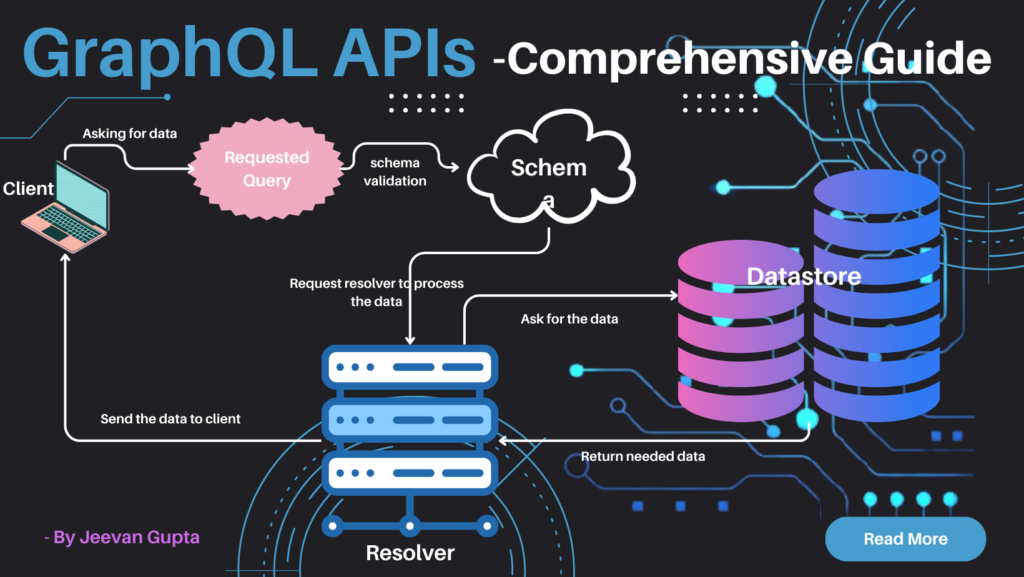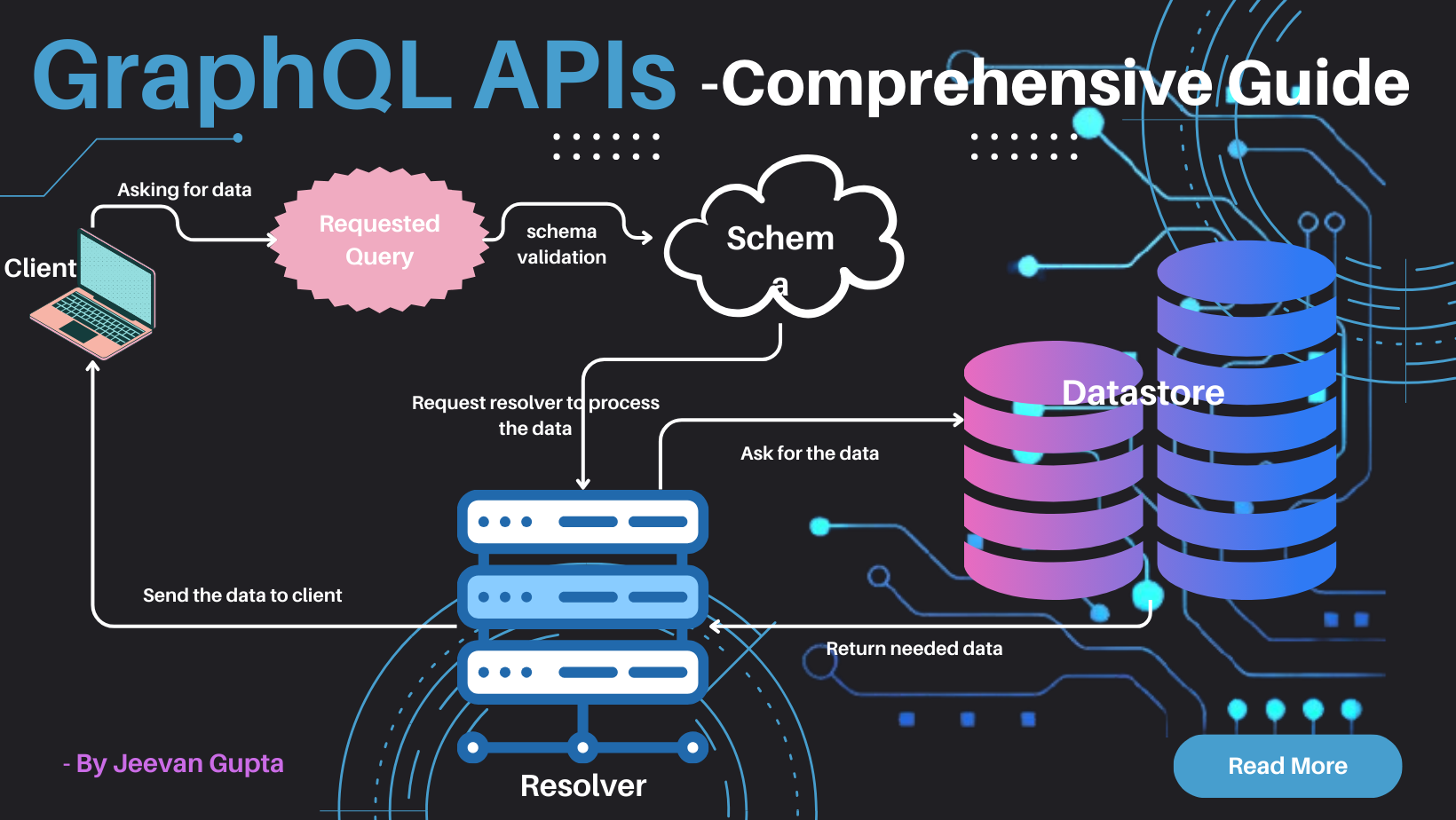A comprehensive guide to GraphQL APIs
Imagine a buffet bursting with information, but you only pick the dishes you crave. That’s the magic of GraphQL, a revolutionary approach to APIs that lets you ditch pre-packaged data and request exactly what you need, no more, no less. Think laser-focused queries, lightning-fast performance, and happier developers – it’s a data buffet dream come true! Intrigued? This comprehensive guide unveils the secrets of GraphQL APIs. We’ll dive into the nitty-gritty, from basic APIs to GraphQL’s unique features, exploring its advantages, limitations, popular examples, python code, and FAQs. Plus, popular APIs in the market using GraphQL and Python code to make GraphQL API calls and FAQs ensure you leave with a full plate of knowledge. Whether you’re a seasoned developer, a tech enthusiast, or a business professional, this article is for you.
Let’s dive in.
Table of Contents:

What is an API?
An API stands for “Application Programming Interface”, a set of rules and protocols that allows different software applications (components) to communicate with each other. It defines the methods and data formats that applications can use to request and exchange information. APIs act as bridges, enabling seamless integration between diverse systems, services, or platforms, and facilitating the sharing of data and functionality. APIs play a crucial role in modern software development by enabling developers to leverage existing functionalities without understanding the internal workings of the systems they interact with or reinvent the wheel.
What is GraphQL API?
GraphQL API is a powerful query language and runtime developed by Facebook, redefining the way we interact with APIs. Unlike traditional counterparts, GraphQL offers unparalleled flexibility and efficiency in data querying and manipulation. Clients can precisely specify the structure of the data they need, eliminating the common issues of over-fetching or under-fetching. As a syntax for data requests, GraphQL allows developers to define the data structure they desire, and the server responds with precisely matching results.
An overview of GraphQL API?
GraphQL APIs revolutionize data querying by empowering clients to make precise requests with specified inputs, ensuring they receive only the data they need. These APIs commonly feature a streamlined structure with a single endpoint, simplifying the request process. The API’s schema, outlining available types and fields, facilitates introspection, allowing clients to discover the API’s capabilities dynamically. This flexibility not only puts more control in the hands of client developers but also optimizes network usage, contributing to enhanced overall performance.
Characteristics and Features of GraphQL APIs
- Precise Data Retrieval:
- Clients can request specific data structures, reducing over-fetching and under-fetching issues common in traditional REST APIs.
- GraphQL allows for fine-grained control over the information retrieved, ensuring optimal efficiency.
- Single Endpoint:
- GraphQL APIs typically expose a single endpoint, simplifying the API’s architecture and making it more predictable compared to multiple endpoints in RESTful architectures.
- Hierarchical Structure:
- Data is represented as a graph with a hierarchical structure, allowing clients to traverse relationships and request nested data in a single query.
- This hierarchical nature aligns well with the way data is often interconnected in modern applications.
- Strong Typing and Introspection:
- GraphQL APIs are strongly typed, meaning the data structure is explicitly defined in a schema.
- Introspection allows clients to explore the API’s capabilities dynamically, enhancing development and documentation.
- Real-time Data with Subscriptions:
- GraphQL supports real-time updates through subscriptions, allowing clients to receive live updates when relevant data changes on the server.
- This feature is invaluable for applications that require instant data synchronization.
- Flexibility in Querying:
- Clients have the freedom to request exactly what they need, enabling flexibility in data querying.
- This flexibility accommodates evolving application requirements without requiring changes to the API itself.
- Efficient Network Usage:
- GraphQL reduces the amount of data transferred over the network by allowing clients to specify their data requirements in the query.
- This efficiency contributes to faster response times and improved overall performance.
- Batched Requests:
- Clients can send multiple queries in a single request, reducing the number of network round-trips and improving performance in scenarios with multiple data needs.
Advantages and limitations of GraphQL APIs
Advantages of Graph APIs:
- Precise Data Fetching: Say goodbye to over-fetching and under-fetching! GraphQL lets you request only the specific data you need, reducing bandwidth usage and improving performance.
- Enhanced Developer Experience: The clear and flexible schema makes development faster and more enjoyable. No more wrestling with complex API documentation or battling unexpected data structures.
- Reduced Server Load: By sending only necessary data requests, GraphQL minimizes server strain, leading to better scalability and efficiency.
- Improved Client Performance: With less data to process, client applications load faster and feel more responsive, enhancing user experience.
- Flexible Schema Evolution: Adapting to changing data needs is a breeze with GraphQL. The schema can be easily modified without breaking existing client integrations.
Limitations of Graph APIs:
- Learning Curve: Compared to REST APIs, GraphQL has a steeper learning curve, especially for developers unfamiliar with its query language and schema-driven approach.
- Server-Side Complexity: Implementing efficient and secure GraphQL servers can be more complex than traditional RESTful ones, requiring additional development effort.
- Limited Error Handling: GraphQL’s error handling mechanisms are still evolving, and some advanced error scenarios might require additional workarounds.
- Caching Challenges: Caching data fetched through GraphQL queries can be trickier than REST APIs due to their dynamic nature.
- Testing Considerations: Testing GraphQL APIs requires new approaches and tools compared to traditional REST testing paradigms.
How do GraphQL APIs work?
A GraphQL API is a powerful tool for interacting with data stored in a graph database. Unlike traditional REST APIs, GraphQL allows clients to efficiently retrieve data by modeling it in terms of nodes and edges, representing objects and relationships. This design enables developers to perform multiple operations on different nodes with a single HTTP request.
Using HTTP/HTTPS requests, each GraphQL endpoint corresponds to a specific operation (GET, POST, PUT, DELETE), and clients can interact with the database seamlessly. Developers make requests, including necessary data in the request body or query parameters, and the API responds with an appropriate HTTP/HTTPS status code along with the requested data.
For instance, consider a server with data on authors, blog posts, and comments. In a REST API, a client might make three separate requests (/posts/123, /authors/455, /posts/123/comments) to get information about a specific blog post, its author, and comments.
In contrast, a GraphQL API empowers the client to formulate a single call that retrieves data from all three resources at once. Furthermore, clients can specify the exact fields they need, offering more control over the response schema. This efficiency and flexibility are key reasons why GraphQL APIs have become popular for modern web development.

Example of Popular GraphQL APIs
- GitHub GraphQL API:
- Description: GitHub’s GraphQL API offers developers a comprehensive way to access and interact with GitHub resources, such as repositories, issues, and pull requests.
- Key Features: Flexibility in data retrieval, real-time updates, and a single endpoint for querying.
- Contentful GraphQL API:
- Description: Contentful’s GraphQL API is generated at the request time based on the content model of each space. It provides a flexible and always up-to-date way to consume both published and non-published content.
- Key Features: Dynamic GraphQL schema, adaptability to content models, and support for both published and draft content.
- SpaceX GraphQL API:
- Description: The SpaceX GraphQL API offers information about previous SpaceX launches, including details about rockets, astronauts, and mission data. It’s a public API with no authorization required.
- Key Features: Access to data on SpaceX launches, rocket trajectories, and mission details.
- AniList GraphQL API:
- Description: The AniList GraphQL API provides access to a vast database of over 500,000 anime and manga entries. It includes information on characters, staff, live airing data, and more.
- Key Features: Extensive anime and manga data, free for non-commercial use, and allows 90 requests per minute.
Programmatic Example – Syntax and Python code to make GraphQL API call
Syntax/Layout:
This retrieves the name and species of a character with ID 123. You can select multiple fields within objects.
query GetCharacter {
character(id: 123) {
name
species
}
}
Dive deeper into your data! You can chain field selections to access related information.
This gets the character's name and a list of friends, including their names and episodes they appear in.
query GetCharacterAndFriends {
character(id: 123) {
name
friends {
name
appearsIn
}
}
}
Python code example:
import requests
import json
# GraphQL endpoint URL
graphql_url = 'https://example.com/graphql'
# GraphQL query to get author details
query = '''
query {
getAuthorDetails(id: "123") {
name
bio
books {
title
publicationYear
}
// Add more fields as needed
}
}
'''
# Headers (if authentication is required)
headers = {
'Authorization': 'Bearer YOUR_ACCESS_TOKEN',
'Content-Type': 'application/json',
}
# Make the GraphQL request
response = requests.post(graphql_url, json={'query': query}, headers=headers)
# Parse and print the response
data = json.loads(response.text)
author_details = data.get('data', {}).get('getAuthorDetails', {})
if author_details:
print("Author Details:")
print(f"Name: {author_details.get('name')}")
print(f"Bio: {author_details.get('bio')}")
books = author_details.get('books', [])
if books:
print("Books:")
for book in books:
print(f" Title: {book.get('title')}")
print(f" Publication Year: {book.get('publicationYear')}")
# Add more book fields as needed
else:
print("No books found for this author.")
# Add more fields as needed
else:
print("Failed to retrieve author details.")
FAQs
1. How does GraphQL differ from REST?
Answer: Unlike REST, GraphQL allows clients to request only the data they need, reducing over-fetching and under-fetching issues. It uses a single endpoint, provides a strongly typed schema, and supports real-time updates through subscriptions.
2. What is a GraphQL schema?
Answer: A GraphQL schema defines the types of data that can be queried and the relationships between them. It serves as a contract between the client and the server, outlining the structure of the data.
3. What is a GraphQL query?
Answer: A GraphQL query is a request for specific data from a GraphQL API. It allows clients to specify the structure of the response and retrieve only the information they need.
4. What is a GraphQL mutation?
Answer: A GraphQL mutation is used to modify data on the server. It is analogous to a POST or PUT request in REST and is commonly used for creating, updating, or deleting data.
5. How do I compare the efficiency of GraphQL vs. REST APIs?
Answer:
While there’s no universal equation, consider these factors:
- Data Fetching: GraphQL’s client-driven approach avoids over-fetching data, potentially reducing bandwidth usage and improving perceived performance.
- Server Load: Complex nested queries in GraphQL might be computationally expensive for the server compared to simpler REST requests.
- Development Complexity: GraphQL’s schema and query syntax require additional learning compared to traditional REST interfaces.
Summary
GraphQL is a powerful tool for building modern, performant, and developer-friendly APIs. However, it’s crucial to weigh its advantages and limitations against your specific needs and project context.
If your application benefits from flexible data fetching, efficient performance, and a clear development experience, GraphQL might be the perfect fit. But if your project requires simpler implementation, established tooling, and a gentler learning curve, REST APIs might be a better choice. Ultimately, the best approach depends on your unique requirements and priorities. So, evaluate both sides of the equation before taking the plunge into the GraphQL world!
If you like this article and think it was easy to understand and might help someone you know, do share it with them. If you want my help, you can reach out to me through this Contact Form to discuss your specific needs and requirements. Thank You! See you soon.
For any suggestions or doubts ~ Get In Touch
Checkout out my other API Integration and Setup Guide
